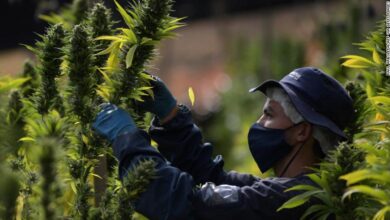How likely are MPs to back a second referendum on Brexit?

Theresa May's deal is dead. At least for now. At the third time of asking, 286 MPs backed the Prime Ministers Brexit deal – 44 more than last time – but still 30 MPs short. The UK is now set to leave the EU in two weeks without a deal on 12 April, although European Council president Donald Tusk has called an emergency summit for 10 April. The EU is likely to offer the UK a long extension to "rethink" its Brexit process.
Barring an early general election, that process now hinges on a second round of “indicative votes” set to take place on Monday. On Wednesday, in the first round of votes, two motions won significant support: a proposal for the UK to leave the EU but remain within a customs union; and a confirmatory vote on any deal passed by parliament – i.e. a second referendum.
Crucially, both proposals won proportionately more support than May's deal. While 286 MPs voted for the Withdrawal Agreement yesterday, 344 voted against it. In other words, May won over only 45.4 per cent of the MPs who voted. On Wednesday, the proposal for a customs union won over fewer MPs – 265 – but was only opposed by 271. With 49.4 per cent of MPs supporting the plan, it came within a whisker of winning a majority. A customs union may indeed turn out to be the House of Commons preferred way forward, but what of a second referendum?
Two hundred and sixty eight MPs backed a new public vote, with 295 opposed: that makes 47.6 per cent in favour – fewer than support a customs union, but more than May's deal. Having been dismissed by many since June 2016, a second referendum is now a genuine possibility. Its fate largely lies with the 75 MPs who abstained from voting. If all other votes are unchanged, they need to split 7:3 in favour of a referendum. The problem? It's very hard to see how that happens.
Thirty five are Tory government ministers. They were all told to abstain. Of these, 15-20 appear implacably opposed to a second referendum. Some hope to replace May as prime minister – from Jeremy Hunt, Gavin Williamson and Sajid Javid, to Liz Truss and Andrea Leadsom. With only around 30 per cent of Tory 2017 voters backing a second referendum, no leadership hopeful is likely to risk infuriating the remaining 70 per cent.
There is a sliver of hope among the handful of ministers who have expressed tepid support for the idea. At best, this group includes Philip Hammond, David Lidington and Amber Rudd, whose constituencies only narrowly voted Leave, as well as David Gauke and Greg Clark, whose constituents backed Remain. All five have at least not ruled out the idea, with Rudd saying she can see the argument, and Hammond agreeing a second referendum deserves to be considered.
There are perhaps eight or ten others, led by Mark Field and Stephen Hammond, two London MPs who represent heavily Remain seats, as well as four others (Anne Milton, Caroline Noakes, David Rutley, Jeremy Wight) in Remain seats, and a handful in closely-fought constituencies, such as Tobias Ellwood and Nick Hurd, who could conceivably be won over in a free vote.
A further 16 abstainers are backbench Tory MPs. Of these, six feel like reasonable targets for the People's Vote campaign: Alistair Burt, Steve Brine and Richard Harrington – the three ministers who resigned this week to support the indicative vote process – and three others in Remain seats (Alex Chalk, Sarah Newton, Ed Vaizey) who haven't dismissed the idea outright.
This best-case scenario would involve around 20 Tories backing the motion, with 15 ministers opposing it and the rest continuing to abstain. That appears to be all People's Vote campaigners can hope for from MPs such as Ken Clarke and John Howell, who, despite representing strongly Remain seats, have been consistent in their opposition to another referendum.
Twenty Tory converts would reflect the hopes of one prominent People's Vote campaigner, who knows of several ministers who could be prepared to switch. But even that would leave a second referendum motion perilously close to defeat. Adding 20 to 268, and 15 to 295, would take the pro-referendum side to 283 and the opposition to 310. Three hundred and twenty votes are needed for a majority in the current House of Commons.
There were 24 other abstentions: 18 Labour MPs, two SNP MPs and two independents. This is where the arithmetic starts to crunch. Of these, only a handful seem to be possible switchers. While 32 of the SNP's 35 MPs backed the partys call for a second vote, two of their MPs – Pete Wishart and Angus MacNeil – believe it threatens the Scottish independence cause. If Brexit is put to a confirmatory vote, they fear that independence may well be following a second Scottish referendum.
A third SNP MP and one independent (John McNally and Jared O'Mara) were absent, though both have in the past backed a new public vote. Both represent strongly Remain seats – if we optimistically add them, a People's Vote is up to around 285.
To get into the 300s, almost all Labour abstainers would need to be won over. But a number have been adamant in their opposition, with MPs in strongly Leave seats – such as Gloria De Piero, Julie Cooper, Lisa Nandy, and Ian Lavery – suggesting that a new vote would “break our democracy”, disrespect the 2016 referendum, or be inconclusive.
There are no soft targets: no abstaining Labour MP represents a constituency that voted Remain. Campaigners believe only half a dozen Labour MPs could be won over as a last resort to avert no deal. The second referendum tally has run aground in the lowRead More – Source
[contf]
[contfnew]

new statesman america
[contfnewc]
[contfnewc]


